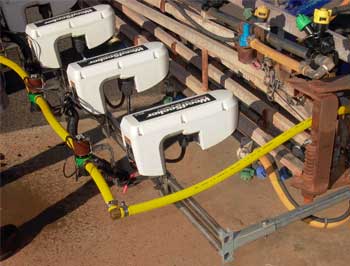West Australia
June 20, 2007
West Australian researchers have
developed a new use for Weedseeker® technology that limits wild
radish seed set in wheat crops and reduces herbicide costs by as
much as 95 per cent.
Department of Agriculture and Food West Australia weeds research
officer, Peter Newman, used the innovative Weedseeker®
technology to detect green wild radish in a fully matured wheat
crop.
“The subsequent seed set of wild radish diminished dramatically
using the technology,” he said.
 At
a Mingenew trial 99.8 per cent seed set control was achieved
when wild radish was sprayed with diquat (Reglone®) at one litre
per hectare through the Weedseeker® units, setting only 12
viable seeds per plant, compared to 5700 when not sprayed. At
a Mingenew trial 99.8 per cent seed set control was achieved
when wild radish was sprayed with diquat (Reglone®) at one litre
per hectare through the Weedseeker® units, setting only 12
viable seeds per plant, compared to 5700 when not sprayed.
The trial host grower, Aiden Obst said there was a fit for the
Weedseeker® technology in wild radish control and he welcomed
its application on a broader scale.
“Due to the dry start to the 2006 season, the trial paddock had
a split germination of wheat, so we couldn’t use an Ester
herbicide and so sprayed it later with Logran and oil,” he said.
“But this did not remove all the radish, so the subsequent wheat
had to be graded.
“We then used the Weedseeker® on some radish that the Logran had
missed and the results speak for themselves,” he said.
The Grains Research and
Development Corporation (GRDC) supported West Australian
trials achieved 87 per cent seed set control in another trial at
Yuna.
In a third Mingenew trial in lupins, there was only 45 per cent
control, which was expected due to some late rain at the site
slowing lupin maturation.
Weedseeker® technology is used for summer weed spraying, couch
grass and knockdowns for a range of weed sizes and also helps
growers control glyphosate resistant ryegrass in the eastern
states.
This is the first time Weedseeker® has been used for in-crop
wild radish control.
The technology uses infra-red and near infra-red light to detect
green weeds and sprays only green plants.
According to Mr Newman, in situations where wild radish is
sprayed with phenoxy herbicides in-crop, the resistant survivors
are often late to flower and set seed, so the wild radish only
begins to set seed after the cereal crop has fully matured.
“When this occurs, spraying wheat at one to three litres per
hectare with a dessicant herbicide, such as diquat (Reglone®),
after full crop maturity, achieves high levels of seed set
control,” he said.
“While spraying the whole paddock is very costly, Weedseeker®
can limit these costs by only spraying the green plants
detected.”
Wild radish resistance to SU (group B) and phenoxy (group I)
herbicides is one of the major challenges facing farmers in West
Australia’s northern agricultural region.
“Stopping seed set of resistant survivors is critical to stop
the development of resistance and manage the wild radish seed
bank,” Mr Newman said.
“Although the main drawback is the cost of the technology, for
larger farms it will pay for itself in reduced herbicide cost
when spraying summer weeds.
“Further research is needed, but early indications are very
exciting,” he said. |
|